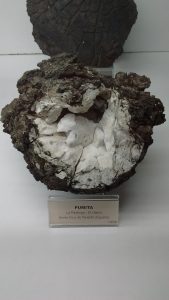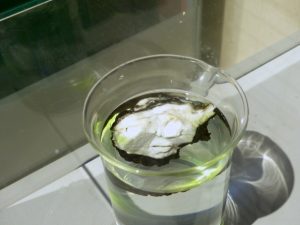One of the nice things about looking for photos for my recent (quite lazy) blog posts is that it’s reminded me that I have a huge number of photos I’ve never really looked at since I took them. Case in point: Last year, I went to Madrid and, amongst other things, had a fabulous time looking around the Museo Geominero (Geomineral Museum) and the Museo Nacional de Ciencias Naturales (National Museum of Natural Sciences). No one will be surprised to hear that I look at lot of photos.
As a lapsed geologist, I was particularly excited to find at both museums examples of the “restingolites”, the pumice-like floating rocks produced by the El Hierro marine eruption of 2011-12 that resembled a coconut. They were called restingolites after the town of La Restinga, the nearest town to the eruption site off the south of the island.
The pale insides of the restingolite were found to be sedimentary layers that were picked up, melted by and coated in the ascending lava, the dark basanite (pdf). I’d followed the eruption quite closely when it was going on, including the conversations about what on earth these weird floating rocks were, so it was very exciting to actually see them in person!
And a floating sample:
Looking through the rest of my Madrid photos, there are some stonkers, so I might just have to publish more!
{ Comments on this entry are closed }







